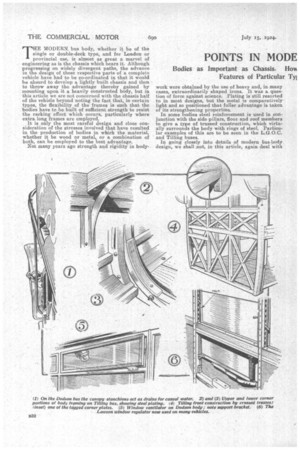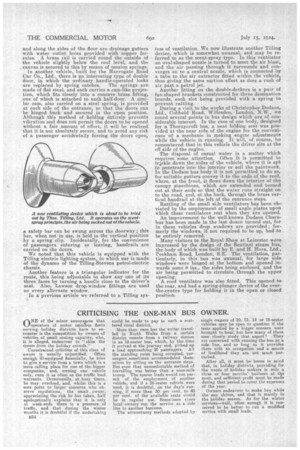POINTS IN MODE JS-BODY DESIGN.
Page 16

Page 17

Page 18

If you've noticed an error in this article please click here to report it so we can fix it.
Bodies as Important as Chassis. Ho' Features of Particular Tyi !sign has Permitted Weight Reduction. ovel System of Ventilation.
THE MODERN, bus body, whether it be of the single or double-deck type, and for London or provincial use, is almost as great a marvel of engineering as is the chassis which bears it. Although progressing on widely divergent paths, the advance in the design of these respective parts of a complete vehicle have had to be co-ordinated in that it would be absurd to develop a lightly built chassis and then to throw away the advantage thereby gained by mounting upon it a heavily constructed body, but in this article we are not concerned with the chassis half of the vehicle beyond noting the fact that, in certain types, the flexibility of the frames is such that the bodies have to be built of sufficient strength to resist the racking effect which occurs, particularly where extra long frames are employed.
It is only the most careful design and close consideration of the stresses involved that have resulted in the production of bodies in which the material, whether it be wood or metal, or a combination of both, can be employed to the best advantage. Not many years ago strength and rigidity in body work were obtained by the use of heavy and, in many cases, extraordinarily shaped irons. It was a question of force against science. Plating is still resorted to in most designs, but the metal is comparatively light and so positioned that fuller advantage is taken of its strengthening properties. In some bodies steel reinforcement is used in conjunction with the side pillars, floor and roof members to give a type of trussed construction, which virtually surrounds the body with rings of steel. Particular examples of this are to be seen in the L.G.O.C. and Tilling buses. In going closely into details of modern bus-body design, we shall not, in this article, again deal with
the constructional features of the K, S and NS-type buses constructed by the L.G.O.C., necause we have already in these columns dealt with them so fully. It is probable that there is no bus body in general use that is stronger, coupled with the lightest possible weight, than the one developed and manufactured at Chiswick. An examination of bodies received for annual overhaul fully confirms this impression. Some of the features of the bodies made by Thomas Tilling, Ltd., are worthy of special mention. For instance, the whole front of each of their double-deck bodies below the windows is constructed on the trussed-girder principle, the details of which can be understood by referring to the .drawings.
The crossed trusses are reinforced by sheet-metal plates, which are turned round the side pillars so that no shearing stresses are imposed on the screws, whilst the trusses are 11110A securely bound together, and warping of the body is rendered virtually impossible.
At each rear corner is a combined tension and compression rod, which also assists in reventing any lateral movement In the case of the front trusses, as these are in compression, there might be a tendency for them to force apart certain of the joints in the body framework, and to prevent this occurring the compression stresses are taken by small angle plates, each of which has one end tagged into the wood.
One Tilling body which has particularly interested us is a single-decker built for the North Western Road Car Co., Ltd. This has no roof in the ordinary sense of the word, hut is provided with a loose canvas cover, which can be rolled right over on to a short, permanent front section of roof which is covered with sheet aluminium. All the panels are of aluminium,
and along the sides of the floor are drainage gutters with water outlet holes provided with copper ferrules. A brass rail is carried round the outside of the vehicle slightly below the roof level, and the • canvas is secured to this by means of tension springs. In another vehicle, built for. the Harrogate Road Car Co., Ltd., there is an interesting type of double door, in which the ordinary handle-operated locks are replaced by spring catches. The springs are made of flat steel, and each carries a cam-like projection, which fits closely into a concave brass fitting, one of which is attached to each half-door. A similar cam, also carried on a steel spring, is provided at each side of the entrance, so that the doors can be hinged back and secured in the open position. Although tins method of holding entirely prevents vibration and does not permit the doors to be opened without a fair amount of effort, it will be realized that it is not absolutely secure, and to avoid any risk of a passenger accidentally forcing the doors open,
a safety bar can be swung across the doorway ;. this bar, when not in use, is held in the vertical position by a spring clip. Incidentally, for the convenience of passengers entering or leaving, handrails are carried on the doors.
We noted that this vehicle is equipped with the Tilling electric lighting system, in which use is made of the dynamo of the Tilling-Stevens petrol-electric chassis.
Another feature is a triangular indicator for the route, this being adjustable to show any one of its three faces by turning a handle close to the driver's seat. Also, Lawson drop-window fittings are used on every alternate window.
In a previous article we referred to a Tilling sys
tern of ventilation. We now illustrate another Tilling device, which is somewhat unusual, and may be referred to as the scent-spray type. In this ventilator an oval-shaped nozzle is turned to meet the air blast, and the air passing through it surrounds and converges on to a central nozzle, which is connected by a tube to the air extractor fitted within the vehicle, thus giving the same suction effect as does a rush of air past a petrol jet. Another fitting on the double-deckers is a pair of fan-shaped brackets constructed for three destination boards, each slot being provided with a spring to prevent rattling. During a visit to the works of Christopher Dodson, Ltd., CobTkold Road, Willesden, London, N.W., we noted several points in bus design which are of considerable interest. In the case of one body, designed for a Thornycroft bus, a neat folding seat was provided at the near side of the engine for the convenience of a mechanic in making engine adjustments while the vehicle is running. It will, of course, be remembered that in this vehicle the driver sits at the off side of the engine. The disposal of casual water is a matter which requires some attention. Often it is permitted to trickle down the sides of the vehicle, where it is apt to penetrate into the interior or soil the paintwork. In the Dodson bus body it is not permitted to do so, for suitable gutters convey it to the ends of the roof, where, at the front, it flows down the interior of the canopy stanchions, which are extended and turned out at their ends so that the water runs straight on to the road, and, at the back, through the brass vertical handrail at the left of the entrance steps.
Rattling of the small side ventilators has been oh-' viated by the employment of small angle plates upon which these ventilators rest when they are opened.
An improvement to the well-known Dodson Charabus has been made in the last dozen turned out, for in these vehicles drop windows are provided ; formerly the windows, if not required to be up, had to be entirely removed.
Many visitors to the Royal Show at Leicester were impressed by the design of the Sentinel steam bus, the body of which was built by E. and H. Hora, Ltd., Peckham Road, London, S.E. The ventilation, particularly, in this bus was unusual, for large side windows were hinged at the bottom and opened inwards some 8 ins., the sides being enclosed, and the air being permitted to circulate through the upper opening. A roof ventilator was also fitted. This opened to the rear, and had a spring-plunger device of the overthe-centre type for holding it in the open or closed position.
































